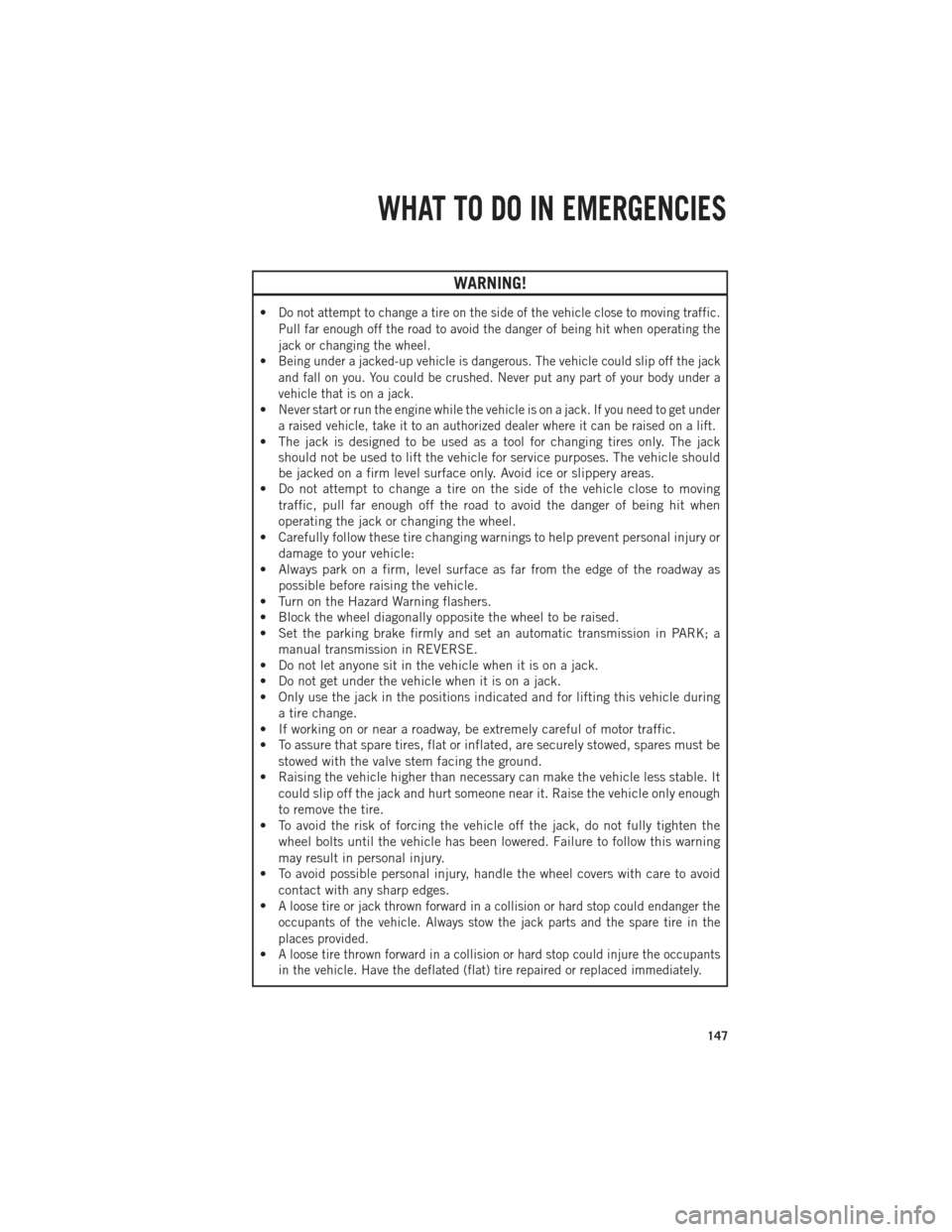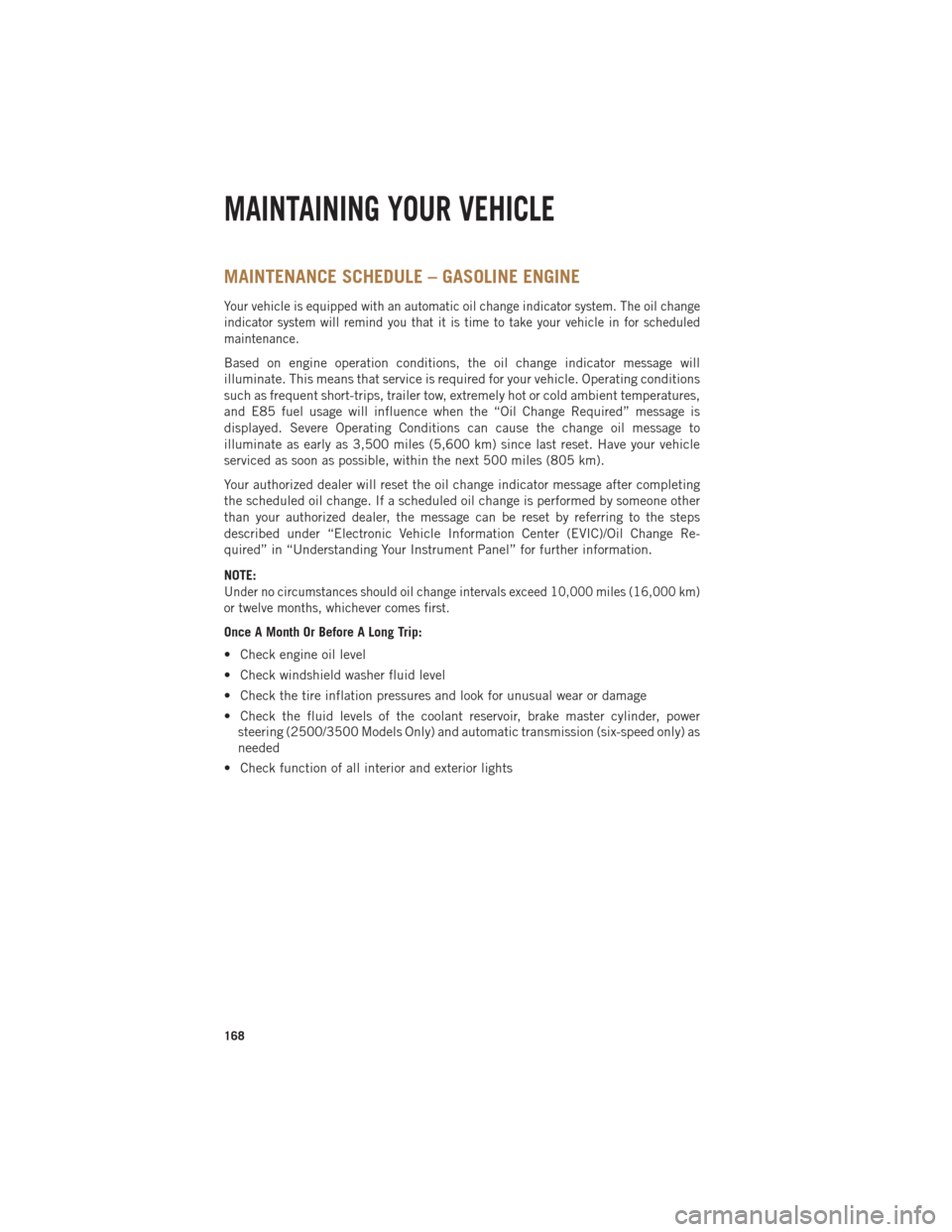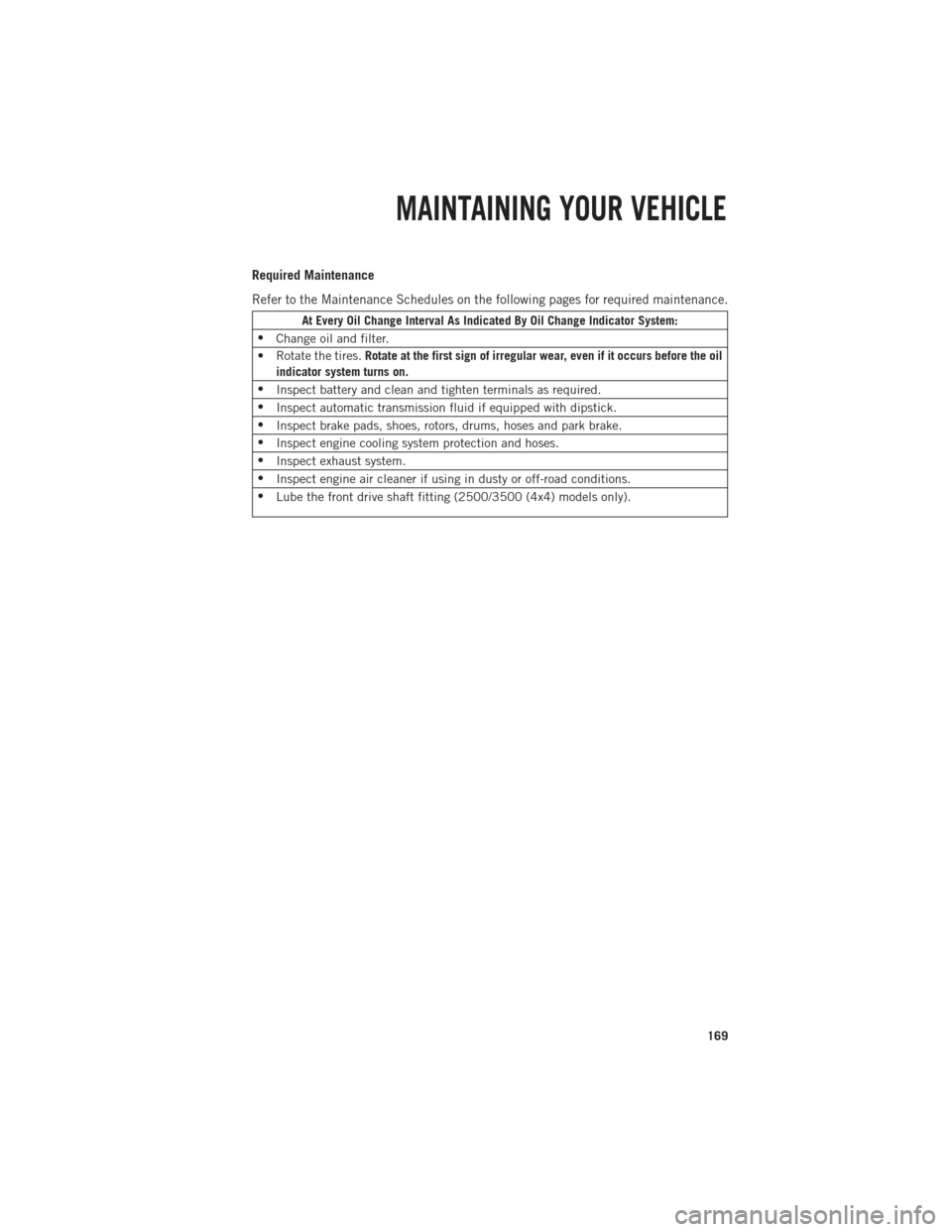automatic transmission Ram 1500 2013 Get to Know Guide
[x] Cancel search | Manufacturer: RAM, Model Year: 2013, Model line: 1500, Model: Ram 1500 2013Pages: 196, PDF Size: 9.66 MB
Page 124 of 196

CAUTION!
Use of aftermarket exhaust brakes is not recommended and could lead to engine
damage.
WARNING!
Do not use the exhaust brake feature when driving in icy or slippery conditions as
the increased engine braking can cause the rear wheels to slide and the vehicle to
swing around with the possible loss of vehicle control, which may cause a collision
possibly resulting in personal injury or death.
IDLE-UP FEATURE (AUTOMATIC TRANSMISSION ONLY)
•The Idle-Up Feature uses the speed control switches to increase engine idle speed
and quickly warm the vehicle’s interior. This feature must be enabled by your dealer.
See your local dealer.
•With the transmission in PARK, the parking brake applied, and the engine running,
push the speed control ON/OFF switch on, then push the SET switch.
• The engine RPM will go up to 1100 RPM. To increase the RPM, push and hold the RESUME/ACCEL switch and the idle speed will increase to approximately
1500 RPM. To decrease the RPM, push and hold the SET/DECEL switch and the
idle speed will decrease to approximately 1100 RPM.
• To cancel the Idle Up Feature, either push the CANCEL switch, push the ON/OFF switch or push the brake pedal.
DIESEL
122
Page 149 of 196

WARNING!
•Do not attempt to change a tire on the side of the vehicle close to moving traffic.
Pull far enough off the road to avoid the danger of being hit when operating the
jack or changing the wheel.
•Being under a jacked-up vehicle is dangerous. The vehicle could slip off the jack
and fall on you. You could be crushed. Never put any part of your body under a
vehicle that is on a jack.
•Never start or run the engine while the vehicle is on a jack. If you need to get under
a raised vehicle, take it to an authorized dealer where it can be raised on a lift.
• The jack is designed to be used as a tool for changing tires only. The jackshould not be used to lift the vehicle for service purposes. The vehicle should
be jacked on a firm level surface only. Avoid ice or slippery areas.
• Do not attempt to change a tire on the side of the vehicle close to moving
traffic, pull far enough off the road to avoid the danger of being hit when
operating the jack or changing the wheel.
• Carefully follow these tire changing warnings to help prevent personal injury or
damage to your vehicle:
• Always park on a firm, level surface as far from the edge of the roadway as
possible before raising the vehicle.
• Turn on the Hazard Warning flashers.
• Block the wheel diagonally opposite the wheel to be raised.
• Set the parking brake firmly and set an automatic transmission in PARK; a
manual transmission in REVERSE.
• Do not let anyone sit in the vehicle when it is on a jack.
• Do not get under the vehicle when it is on a jack.
• Only use the jack in the positions indicated and for lifting this vehicle during
a tire change.
• If working on or near a roadway, be extremely careful of motor traffic.
• To assure that spare tires, flat or inflated, are securely stowed, spares must be
stowed with the valve stem facing the ground.
• Raising the vehicle higher than necessary can make the vehicle less stable. It
could slip off the jack and hurt someone near it. Raise the vehicle only enough
to remove the tire.
• To avoid the risk of forcing the vehicle off the jack, do not fully tighten the
wheel bolts until the vehicle has been lowered. Failure to follow this warning
may result in personal injury.
• To avoid possible personal injury, handle the wheel covers with care to avoid
contact with any sharp edges.
•
A loose tire or jack thrown forward in a collision or hard stop could endanger the
occupants of the vehicle. Always stow the jack parts and the spare tire in the
places provided.
•A loose tire thrown forward in a collision or hard stop could injure the occupants
in the vehicle. Have the deflated (flat) tire repaired or replaced immediately.
WHAT TO DO IN EMERGENCIES
147
Page 150 of 196

JUMP-STARTING
• If your vehicle has a discharged bat-tery it can be jump-started using a set
of jumper cables and a battery in an-
other vehicle or by using a portable
battery booster pack.
•
Jump-starting can be dangerous if done
improperly so please follow the proce-
dures in this section carefully.
NOTE:
When using a portable battery booster
pack follow the manufacturer’s operating
instructions and precautions.
Preparations for Jump-Start
• The battery in your vehicle is located in the front of the engine compartment, behind the left headlight assembly.
NOTE:
The positive battery post is covered with a protective cap. Lift up on the cap to gain
access to the positive battery post.
• Set the parking brake, shift the automatic transmission into PARK and turn the ignition to OFF.
• Turn off the heater, radio, and all unnecessary electrical accessories.
• If using another vehicle to jump-start the battery, park the vehicle within the jumper cables reach, set the parking brake and make sure the ignition is OFF.
Jump-Starting Procedure
• Connect the positive (+)end of the jumper cable to the positive (+)post of the
discharged vehicle.
• Connect the opposite end of the positive (+)jumper cable to the positive (+)post
of the booster battery.
• Connect the negative end (-)of the jumper cable to the negative (-)post of the
booster battery.
• Connect the opposite end of the negative (-)jumper cable to a good engine ground
(exposed metal part of the discharged vehicle’s engine) away from the battery and
the fuel injection system.
• Start the engine in the vehicle that has the booster battery, let the engine idle a few minutes, and then start the engine in the vehicle with the discharged battery.
WHAT TO DO IN EMERGENCIES
148
Page 164 of 196

FLUIDS AND CAPACITIES
Gasoline Versions
Component Fluid, Lubricant, or Genuine Part Capacities
Engine Coolant
3.6L, 4.7L Engine We recommend you use MOPAR®
Antifreeze/Coolant 10 Year/
150,000 Mile Formula OAT
(Organic Additive Technology). 14 Quarts (13 Liters)
Engine Coolant
5.7L 1500 Models We recommend you use MOPAR
®
Antifreeze/Coolant 10 Year/
150,000 Mile Formula OAT
(Organic Additive Technology). 16 Quarts (15 Liters)
Engine Coolant
5.7L 2500/3500 Models We recommend you use MOPAR
®
Antifreeze/Coolant 10 Year/
150,000 Mile Formula OAT
(Organic Additive Technology) .18.7 Quarts (17.7 Liters)
Engine Coolant
5.7L 2500/3500
Models w/Heavy Duty We recommend you use MOPAR®
Antifreeze/Coolant 10 Year/
150,000 Mile Formula OAT
(Organic Additive Technology) .19.2 Quarts (18.2 Liters)
Engine Oil with Filter 3.6L, 4.7L, 5.7L We recommend you use
API certified 5W-20 engine oil, meeting the requirements ofChrysler Material Standard
MS-6395. Refer to you oil filler cap for correct SAE grade. 3.6L Engine - 6 Quarts
(5.7 Liters)
4.7L Engine - 6 Quarts (5.7 Liters)
5.7L Engine - 7 Quarts (6.6 Liters)
Engine Oil with Filter 5.7L
For 2500/3500 trucksoperating with a gross combined weight
rating greater than
14,000 lbs/(6,350 kg)
We recommend you use
API Certified SAE 5W-30 engine oil, meeting the requirements of Chrysler Material Standard
MS-6395. Refer to your engine oil filter cap for correct SAE grade. 5.7L Engine - 7 Quarts
(6.6 Liters)
Engine Oil Filter
3.6L, 4.7L, 5.7L We recommend you use MOPAR
®
Engine Oil Filters.
—
Spark Plug 3.6L We recommend you use MOPAR®
Spark Plugs. —
Spark Plug 4.7L We recommend you use MOPAR®
Spark Plugs. —
Spark Plug 5.7L We recommend you use MOPAR®
Spark Plugs. —
Automatic
Transmission —
Eight-Speed AutomaticWe recommend you use Mopar®
ZF 8&9 Speed ATF™ Automatic Transmission Fluid. —
MAINTAINING YOUR VEHICLE
162
Page 165 of 196

Component Fluid, Lubricant, or Genuine Part CapacitiesAutomatic
Transmission —
Six-Speed Automatic
with Gasoline Engine We recommend you use MOPAR®
ATF+4 Automatic Transmission
Fluid. —
Manual Transmission G-56 We recommend you use MOPAR
®
ATF+4 Automatic Transmission
Fluid. —
Transfer Case We recommend you use MOPAR
®
BW44–44 Transfer Case Fluid. —
Front Axle 1500
Four-Wheel Drive Models We recommend you use GL-5
SAE 75W-90 MS-9763. —
Rear Axle 1500 Models
We recommend you use MOPAR®
Synthetic Gear Lubricant SAE
75W-140 MS-8985. Limited-Slip Rear Axles require the additionof 118 ml (4 oz) of MOPAR
®
Limited Slip Additive MS-10111. —
Front and Rear Axle 2500/3500 Models We recommend you use
Synthetic, GL-5 SAE 75W-90. Limited-Slip 10.5/11.5 inch
Rear Axles Limited slip additive is not required. —
Brake Master Cylinder We recommend you use MOPAR
®
DOT 3 and SAE J1703. If DOT 3
is not available, then DOT 4 is acceptable. —
Power Steering Reservoir We recommend you use MOPAR
®
Power Steering Fluid +4 or
MOPAR®ATF+4®Automatic
Transmission Fluid. —
Fuel Selection 3.6L, 4.7L 87 Octane1500 Regular
Cab Shortbed/Crew
Quad Cab - 26 Gallons (98 Liters) (Approxi-
mate) 1500 Regular Cab Longbed/Crew
Quad Cab (Optional) -
32 Gallons (121 Liters) (Approximate)
2500/3500 Shortbed -
34 Gallons (129 Liters) (Approximate)
2500/3500 Longbed -
35 Gallons (132 Liters) (Approximate)
MAINTAINING YOUR VEHICLE
163
Page 167 of 196

Component Fluid, Lubricant, or Genuine Part Capacities
Fuel Selection
6.7L Turbo Diesel Use good quality diesel fuel
from a reputable supplier in your
vehicle. Federal law requires that you must fuel this vehicle with
Ultra Low Sulfur Highway Diesel fuel (15 ppm Sulfur maximum) and prohibits the use of LowSulfur Highway Diesel fuel
(500 ppm Sulfur maximum) to avoid damage to the emissions control system. For most year-
round service, No. 2 diesel fuel meeting ASTM specification
D-975 Grade S15 will provide
good performance. If the vehicle is exposed to extreme cold(below 20°F or -7°C), or is
required to operate at colder-
than-normal conditions for pro- longed periods, use climatized No. 2 diesel fuel or dilute the No. 2 diesel fuel with 50%
No. 1 diesel fuel. This will provide better protection from fuel gellingor wax-plugging of the fuel filters. This vehicle is fully compatible with biodiesel blends up to
5% biodiesel meeting ASTM specification D-975. Standard Rear Tank -
52 Gallons (197 Liters)
Optional Midship Tank - 22 Gallons (83 Liters)
Engine Oil Filter 6.7L Engine We recommend you use MOPAR
®
Engine Oil Filters.
—
Engine Fuel Filter 6.7L Turbo Diesel We recommend you use MOPAR®
Fuel Filter. Must meet 5 micron
rating. Using a fuel filter that
does not meet the manufacturer's filtration and water separating
requirements can severely impact fuel system life and reliability. —
Crankcase Ventilation Filter 6.7L Turbo Diesel We recommend you use
MOPAR
®CCV Filter. —
Automatic
Transmission
(5-Speed 545RFE) MOPAR
®ATF+4®Automatic
Transmission Fluid or equivalent licensed ATF+4
®product. —
MAINTAINING YOUR VEHICLE
165
Page 168 of 196

Component Fluid, Lubricant, or Genuine Part CapacitiesAutomatic
Transmission
(6-Speed AS68RC) MOPAR®AS68RC Automatic
Transmission Fluid or equivalent.
Clutch Linkage We recommend you use MOPAR
®
Multi-Purpose Grease,
NLGI Grade 2 E.P. —
Manual Transmission G-56 We recommend you use MOPAR
®
ATF+4®Automatic Transmission
Fluid. —
Transfer Case We recommend you use MOPAR
®
BW44–44 Transfer Case Fluid. —
Front and Rear Axle We recommend you use
Synthetic, GL-5 SAE, 75W-90 Synthetic (MS-9763). —
Brake Master Cylinder We recommend you use MOPAR
®
DOT 3. If DOT 3 is not available,
then DOT 4 is acceptable. Use
only recommended Brake Fluids. —
Power Steering Reservoir We recommend you use MOPAR
®
Power Steering Fluid +4 or
MOPAR®ATF+4®Automatic
Transmission Fluid. —
Diesel Exhaust Fluid Tank (Approximate) We recommend you use
MOPAR
®Diesel Exhaust Fluid
(API Certified) (DEF) or equivalent that has been API Certified to
the ISO 22241 standard. Use of fluids not API Certified toISO 22241 may result in system damage. 5.5 Gallons (21 Liters)
MAINTAINING YOUR VEHICLE
166
Page 170 of 196

MAINTENANCE SCHEDULE – GASOLINE ENGINE
Your vehicle is equipped with an automatic oil change indicator system. The oil change
indicator system will remind you that it is time to take your vehicle in for scheduled
maintenance.
Based on engine operation conditions, the oil change indicator message will
illuminate. This means that service is required for your vehicle. Operating conditions
such as frequent short-trips, trailer tow, extremely hot or cold ambient temperatures,
and E85 fuel usage will influence when the “Oil Change Required” message is
displayed. Severe Operating Conditions can cause the change oil message to
illuminate as early as 3,500 miles (5,600 km) since last reset. Have your vehicle
serviced as soon as possible, within the next 500 miles (805 km).
Your authorized dealer will reset the oil change indicator message after completing
the scheduled oil change. If a scheduled oil change is performed by someone other
than your authorized dealer, the message can be reset by referring to the steps
described under “Electronic Vehicle Information Center (EVIC)/Oil Change Re-
quired” in “Understanding Your Instrument Panel” for further information.
NOTE:
Under no circumstances should oil change intervals exceed 10,000 miles (16,000 km)
or twelve months, whichever comes first.
Once A Month Or Before A Long Trip:
• Check engine oil level
• Check windshield washer fluid level
• Check the tire inflation pressures and look for unusual wear or damage
• Check the fluid levels of the coolant reservoir, brake master cylinder, powersteering (2500/3500 Models Only) and automatic transmission (six-speed only) as
needed
• Check function of all interior and exterior lights
MAINTAINING YOUR VEHICLE
168
Page 171 of 196

Required Maintenance
Refer to the Maintenance Schedules on the following pages for required maintenance.
At Every Oil Change Interval As Indicated By Oil Change Indicator System:
• Change oil and filter.
• Rotate the tires. Rotate at the first sign of irregular wear, even if it occurs before the oil
indicator system turns on.
• Inspect battery and clean and tighten terminals as required.
• Inspect automatic transmission fluid if equipped with dipstick.
• Inspect brake pads, shoes, rotors, drums, hoses and park brake.
• Inspect engine cooling system protection and hoses.
• Inspect exhaust system.
• Inspect engine air cleaner if using in dusty or off-road conditions.
• Lube the front drive shaft fitting (2500/3500 (4x4) models only).
MAINTAINING YOUR VEHICLE
169
Page 173 of 196

Mileage or time passed (whichever comes first)
20,000
30,000
40,000
50,000
60,000
70,000
80,000
90,000
100,000
110,000
120,000
130,000
140,000
150,000
Or Years: 2 3 4 5 6 7 8 9 10 11 12 13 14 15
Or Kilometers:
32,000
48,000
64,000
80,000
96,000
112,000
128,000
144,000
160,000
176,000
192,000
208,000
224,000
240,000
Flush and replace the engine coolant at
10 years or 150,000 miles (240,000 km)
whichever comes first. XX
Change automatic transmission fluid and
filter(s), if using your vehicle for police, taxi,
fleet, or frequent trailer towing. XChange automatic transmission fluid and filter.
X
Inspect the transfer case fluid, change for any
of the following: police, taxi, fleet, or frequent
trailer towing. X
Change the transfer case fluid. X
Inspect and replace PCV valve if necessary. X
** The spark plug change interval is mileage based only, yearly intervals do not apply.
WARNING!
• You can be badly injured working on or around a motor vehicle. Do only service work for which you have the knowledge and the
right equipment. If you have any doubt about your ability to perform a service job, take your vehicle to a competent mechanic.
• Failure to properly inspect and maintain your vehicle could result in a component malfunction and effect vehicle handling and
performance. This could cause an accident.
MAINTAINING YOUR VEHICLE
171